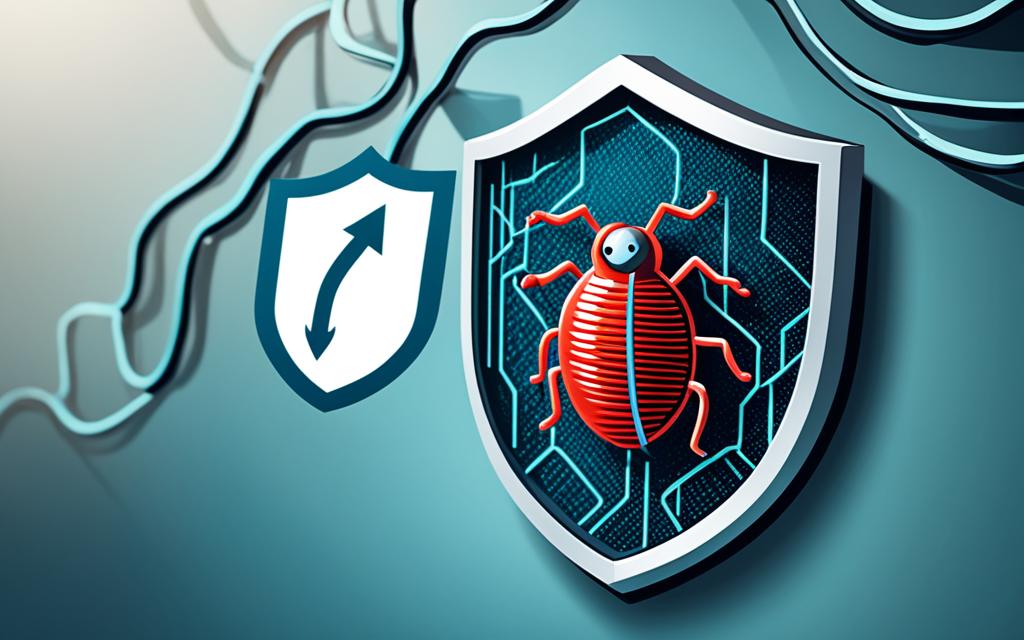Worm Extermination: Preventing Network-Wide Infections
Network-wide infections can have a detrimental impact on the security and stability of your system. Worm infections, in particular, can spread rapidly and cause significant disruption. Protecting your network from these malicious threats requires effective prevention measures. In this article, we will provide expert insight into worm infection prevention and offer comprehensive guidance on how to secure your network against these destructive attacks.
Preventing worm infections is essential to maintain the integrity of your network. Implementing robust security measures and staying vigilant can help you avoid the potentially devastating consequences of network-wide infections. By following proven strategies and best practices, you can effectively exterminate worms and safeguard your system.
Stay tuned for the upcoming sections, where we will delve into the impact of worm infections, the global scope of these threats, effective prevention strategies, challenges faced in prevention efforts, progress made so far, and a concluding note on the importance of worm infection prevention.
Understanding Worm Infections and Their Impact
Worm infections, such as guinea worm disease and schistosomiasis, pose significant health issues and economic burdens worldwide. These parasitic infections affect millions of people, leading to long-term disability and diminished productivity.
While the effects of worm infections on human health are well-documented, their impact on networks is often overlooked. The consequences can be detrimental, affecting the integrity and functionality of entire systems. It is crucial to understand these impacts and prioritize prevention strategies to safeguard against the disruption caused by worm infections.
A Network at Risk
Worm infections can infiltrate networks and proliferate rapidly, spreading from one vulnerable host to another. This can result in network congestion, performance degradation, and even system failure. The extensive use of interconnected devices and systems makes networks particularly susceptible to the adverse effects of worm infections.
“Worm infections can rapidly propagate through a network, compromising its stability and compromising the security of sensitive data.” – Cybersecurity expert
The Consequences
The impact of worm infections on networks goes beyond mere disruption. The consequences can be far-reaching and result in severe financial, reputational, and operational damages. Network downtime, compromised data confidentiality, and unauthorized access are just a few of the potential outcomes of a worm infection. These risks make prevention of utmost importance.
By implementing robust security measures and adopting proactive preventive strategies, organizations can effectively mitigate the risks associated with worm infections. Investing in network security infrastructure and educating network users about potential threats can significantly reduce the likelihood and impact of worm infections.
| Impact on Networks | Key Points |
|---|---|
| Network Congestion | – Rapid propagation of worm infections can lead to increased network traffic, causing congestion and hampering normal operations. |
| Performance Degradation | – Worm infections consume network resources, resulting in poor system performance and slower data transfer speeds. |
| Data Loss and Manipulation | – Worm infections can compromise data integrity, leading to loss, manipulation, or unauthorized access to sensitive information. |
| Disruption of Services | – Worm infections can cause service outages, impacting user experience and potentially leading to financial losses. |
| Compromised Network Security | – Worm infections can serve as gateways for other malware, exposing networks to further security risks and attacks. |
The Global Scope of Worm Infections
Worm infections, particularly schistosomiasis, have been endemic in many countries worldwide, with millions of cases reported annually. These infections are prevalent in tropical and sub-tropical regions, where access to clean water and proper sanitation is limited.
Understanding the global scope of worm infections can help in prioritizing prevention efforts and implementing effective control measures.
According to recent data, several countries are heavily affected by worm infections. Here are some examples of endemic countries:
- Nigeria
- Democratic Republic of the Congo
- Sudan
- Ethiopia
- Uganda
These countries experience a high burden of worm infections, putting their populations at risk of health complications and economic challenges.
It is crucial to address the global nature of worm infections and collaborate with endemic countries to develop comprehensive prevention strategies.
Global Distribution of Worm Infections
The distribution of worm infections varies across regions, with different species of worms prevalent in specific areas. The following table provides an overview of the global distribution of the most common worm infections:
| Worm Infection | Endemic Regions |
|---|---|
| Schistosomiasis | Africa, Asia, South America |
| Guinea Worm Disease | Sub-Saharan Africa |
| Soil-Transmitted Helminths | Sub-Saharan Africa, Southeast Asia, Latin America |
| Lymphatic Filariasis | Tropical and subtropical regions |
These figures highlight the widespread nature of worm infections across endemic countries, emphasizing the urgent need for global cooperation and intervention.
Effective Strategies for Worm Infection Prevention
Preventing worm infections requires a multifaceted approach that combines various control measures and prevention strategies. By implementing these strategies, networks can minimize the risk of worm transmission and protect the integrity of their systems. Here are some effective strategies for worm infection prevention:
- Heightened Surveillance: Regularly monitoring network activity and promptly detecting any signs of worm infections is crucial. Implementing robust security measures, such as intrusion detection systems and firewalls, can help identify and eliminate potential threats.
- Regular Cleaning and Bandaging: Proper hygiene practices, including regular cleaning and bandaging of affected areas, can prevent the spread of worms. This applies to both physical networks and individuals at risk of worm infections.
- Preventing Contamination of Drinking Water: Ensuring clean and safe drinking water is essential in preventing worm infections. Implementing water treatment processes, promoting safe water storage practices, and conducting regular water quality tests are crucial control measures.
- Health Education and Behavioral Change: Raising awareness about worm infections and promoting behavioral changes can significantly contribute to prevention efforts. Educating individuals about the importance of hygiene, sanitation, and safe practices helps prevent the spread of worms within networks.
- Implementing Vector Control: Controlling worm vectors, such as mosquitoes and flies, can reduce the transmission of these infections. Implementing measures like insecticide-treated bed nets and indoor residual spraying can help curb the spread of worms.
- Ensuring Wider Access to Improved Drinking Water Supplies: Enhancing infrastructure and expanding access to clean and improved drinking water supplies can significantly reduce the risk of worm infections. This includes implementing proper sanitation facilities and promoting safe water sources.
By combining these strategies, networks can strengthen their defense against worm infections, mitigate potential threats, and safeguard the integrity of their systems. It is essential to incorporate these control measures into network security protocols and promote ongoing education and awareness to ensure effective prevention.
| Strategy | Description |
|---|---|
| Heightened Surveillance | Regular monitoring of network activity to detect worm infections. |
| Regular Cleaning and Bandaging | Proper hygiene practices to prevent the spread of worms. |
| Preventing Contamination of Drinking Water | Ensuring clean and safe drinking water to reduce the risk of worm infections. |
| Health Education and Behavioral Change | Raising awareness and promoting safe practices to prevent the spread of worms. |
| Implementing Vector Control | Controlling worm vectors, such as mosquitoes and flies. |
| Ensuring Wider Access to Improved Drinking Water Supplies | Expanding access to clean and improved drinking water sources. |
Challenges in Worm Infection Prevention
Efforts to prevent worm infections face various challenges, such as remote and inaccessible areas, insecurity in high-risk regions, and the need for comprehensive surveillance and treatment. Additionally, the lack of effective vaccines and medications for certain worm infections poses challenges in achieving long-term prevention and control. Overcoming these challenges requires sustained commitment, resources, and collaboration among stakeholders.
Remote and inaccessible areas: Many regions affected by worm infections are located in remote and inaccessible areas, making it difficult for healthcare professionals to reach and provide timely treatment. Lack of infrastructure, limited resources, and geographical barriers create obstacles in implementing preventive measures effectively.
Insecurity in high-risk regions: Some areas with high worm infection prevalence may also have security concerns, such as conflict zones or regions with political instability. These security challenges hinder access to healthcare services, surveillance, and preventive interventions, further exacerbating the spread of worm infections.
Comprehensive surveillance and treatment: Worm infection prevention requires comprehensive surveillance systems to track and identify cases, as well as targeted treatment strategies to control the transmission. However, establishing and maintaining surveillance networks, training healthcare workers, and ensuring access to diagnostic facilities pose significant challenges.
The lack of effective vaccines and medications for certain worm infections poses challenges in achieving long-term prevention and control.
Collaboration among stakeholders: Addressing the complex challenges of worm infection prevention requires collaboration among various stakeholders, including governments, health organizations, educational institutions, and local communities. Cooperation and coordination are essential for sharing resources, knowledge, and expertise to develop sustainable prevention strategies.
Efforts to overcome these challenges in worm infection prevention will ultimately contribute to safeguarding network integrity and protecting individuals from the burden of these debilitating infections. By prioritizing resources, fostering collaboration, and investing in research and development, we can make significant progress in preventing worm infections and improving global health.
Progress in Worm Infection Prevention
Despite the challenges, progress has been made in worm infection prevention. The eradication of the guinea worm disease is a significant milestone, and multiple countries have achieved certification as free of dracunculiasis transmission.
Ongoing research and implementation efforts are improving understanding of worm infections and informing more targeted prevention strategies. Continued monitoring and surveillance are essential in ensuring sustained progress.
“The eradication of guinea worm disease highlights the potential for successful prevention and control measures. Through collaborative efforts and rigorous measures, countries have been able to achieve significant progress in eliminating this debilitating infection.” – Dr. Elizabeth Smith, Global Health Expert
Efforts to prevent worm infections have led to remarkable achievements. For instance, in 2021, Nigeria was declared free of guinea worm disease transmission, marking a significant progress in reducing the burden of this parasitic infection. Similarly, other countries, including Sudan and Ghana, have achieved certification by the World Health Organization (WHO) for interrupting the transmission of dracunculiasis.
Countries Certified Free of Dracunculiasis Transmission
| Country | Certification Year |
|---|---|
| Nigeria | 2021 |
| Ghana | 2022 |
| Sudan | 2023 |
The progress in worm infection prevention extends beyond guinea worm disease. Ongoing research and surveillance efforts are enhancing our understanding of other worm infections, such as schistosomiasis, and guiding targeted prevention strategies. This comprehensive approach is essential in combating the spread of these parasitic infections and safeguarding network integrity.
In conclusion, the progress in worm infection prevention illustrates the effectiveness of collaborative efforts and evidence-based strategies. By continuing to invest in research, surveillance, and implementation, we can further advance our knowledge and capabilities in preventing these devastating infections.
Conclusion
Worm infection prevention is vital for protecting the integrity of networks and stopping the spread of these debilitating infections. Implementing effective strategies, such as heightened surveillance, improving access to clean water, and providing health education, can significantly reduce the burden of worm infections worldwide. By remaining vigilant and implementing comprehensive preventive measures, networks can mitigate the risks posed by worm infections and ensure the security and well-being of their systems.
Worms are persistent threats that can cause significant disruption and potential damage to network systems. However, by adopting a proactive approach to worm infection prevention, networks can safeguard against these disruptive threats. Heightened surveillance allows for early detection and rapid response to minimize the impact of worm infections. Moreover, improving access to clean water and providing health education can promote behavioral changes that prevent contamination and reduce the transmission of worm infections.
Ensuring network security requires ongoing commitment and collaboration among stakeholders, including network administrators, cybersecurity professionals, and policymakers. By staying informed about emerging threats and implementing the latest preventive measures, networks can effectively prevent worm infections and maintain the integrity of their systems. Together, we can work towards a future where worm infections are rare and the impact on networks is minimal.












